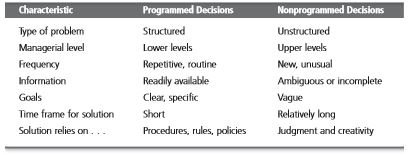7.3: Decisions and Decision-Making Conditions
Decisions are a regular affair in managerial duties. Whether it is unique or commonplace, it is no surprise that problem solving and crisis management are such essential requirements of a manager. Whether it is the adaptation of legislation requiring nutritional information into business practices or making routine decisions like work shifts; managers have to assess the situation carefully and make informed focused on the overall improvement in company performance. Here we will discuss the various style of making a decision and the conditions that play a decisive role in determining their effectiveness.How do manager decide on a suitable alternative and what factors affect their judgment when choosing the preferred option? Why is there so much devastating decision in the modern business scenario? Let’s find out.
 Factors affecting decision making
Factors affecting decision making
While making routine decisions, the roles of a manager may not be highlighted, but in every unique approach to problem solving and decision making, the manager have to take into account certain information before making any kind of informed decisions. The conditions of available information are generally classified into three main categories. The most prominent conditions available for decision making are:
Certainty: –
When a manager knows every outcome of all the possible alternatives, he can choose the best alternative with certainty. It is an ideal situation where the person making the decision is in a position to have all information available to him while making a decision, which ensures guaranteed benefits. For instance, a state treasurer has access to all relevant information regarding to the various banks, in order to choose the optimal location to transfer excess funds. Certainty is very rare in managerial situations. It is a utopian situation where thinking and analysis is not required.
Risk: –
Risk analyses include a probabilistic analysis of past data and compare the benefits to the cost to justify the feasibility of a decision. It is more commonly observable across the managerial platform, and requires accurate and clinical estimation of the likelihood of success among given alternatives. Intuition plays a big role in risk analysis, with many a story to accentuate the fame that follows a masterful risk-taker in the corporate world. Many corporations are risk averse, whereas others thrive on risky investments and market strategies which provide high returns or bust. An example is illustrated to further explain the rudiments of this condition.
Risk analysis involves probabilistic distribution of data and requires and astute observation to spot out a pattern or get a hunch. Intuition plays a part in this type of problems. As an instance, the decision to add another lift in a ski resort depends on various factors for added revenue; such as reliable weather information documenting past years’ amount of snowfall, and the amount of revenue generated during different amounts of snowfall. The average expected value over time can be calculated by multiplying probabilities of snowfall and the corresponding expected revenue. As shown in the figure above, the expected revenue generated in a model problem is $687,500. If this is higher than the cost of installation and maintenance, the project is to be considered feasible.

 Uncertainty: –
Uncertainty: –
When managers do not have all the relevant information available to make an informed decision, a state of uncertainty is reached. Uncertainty arises in risky business ventures, where the future is unknown and present is incomplete. Due to this, managers rely on their inner feelings more than factual info, and most managers tend to make decisions based on their past experience in similar situations, the available information, and their psychological makeup. Let us understand this better with the help of an example.
The marketing manager of a credit card company has chosen four alternative strategies S1, S2, S3, and S4 to promote his product throughout western USA. His counterpart at a competing company has chosen three actions CA1, CA2, and CA3 for promotional purposes in the same region. Assuming no previous knowledge of the competitor’s strategy, the following payoff matrix can be constructed using probabilities of success.
 Optimistic managers tend to go for the maximum benefit of the maximum payoff matrix, considering only best possible outcomes. Pessimistic managers tend to play safe and consider only the worst case scenario, choosing from the maximum payoff in the minimum payoff matrix. Needless to say, none of these approaches are ideal for efficient output.
Optimistic managers tend to go for the maximum benefit of the maximum payoff matrix, considering only best possible outcomes. Pessimistic managers tend to play safe and consider only the worst case scenario, choosing from the maximum payoff in the minimum payoff matrix. Needless to say, none of these approaches are ideal for efficient output.
Based on the matrix, an optimistic manager would choose strategy S4, which would give the largest gain ($28 million), whereas a pessimistic manager would assume the worst, and choose S3 ($15 million), it being the maximum on the minimum payoffs. The psychological makeup observable in such situation can be generalized into three broad classes: optimistic, pessimistic and realistic.
A third approach consists of the inclusion of regret- based on differences in payoffs for different strategies employed. Regret stands for the reaction of a manager when he realizes that adopting another strategy than the one he adopted could have produced a better and more profitable outcome. A regret matrix is then formed based by subtracting the highest payoff in each corresponding strategy employed by the competitor. If regret is calculated for our example, the optimal strategy would be obtained my minimization of the maximum regret i.e., S4, while the competitor would choose CA1. Regret minimization is the proffered choice for realistic manager who are intent of keeping the losses to a minimum, hence choosing the minimum of the maximum regret matrix value.
Classification of decisions
In organizational environments, there are always a bunch of decisions to be made regarding a variety of operations to be undertaken. Some decisions are regularly taken and do not require repetitive thinking and following the usual decision making process. Once a problem has been evaluated and the best alternative already stated, further analysis and repeated interpretation of given data is not required while handling it the next time. Other problems require customized solutions catered to the problem specifications, which can address specific issues illustrated in the defining conditions.
There are many numbers of decisions a manager has to make and implement in his organization. The kind of decisions depends on the nature of the problem present, and can be broadly classified in two types:
Programmed decisions:
A programmed decision can be defined as a “routine approach to handle a repetitive decision”. When a problem is familiar and simple, and the goal is clear, and easily defined, it is called a structured problem. Examples include a news team racing after breaking news, return of goods, late delivery etc. In this type of problems, the decision maker has definite objectives and the best alternative has already been established. These decisions are made routinely and can be grouped together as a protocol for handling a particular situation. Programmed decisions do not require analysis of problem and assessment of alternatives, and can be further classified into three types:
Procedure:
Any series of steps taken sequentially after the identification of a problem can be referred to as a procedure. It is routine activities that do not require any analysis. A manager has to identify the problem and follow the corresponding procedure. The procedures are generally laid in places where the problem identification is largely subjective and varied, and there is no fixed way to react to all incoming situations.
Rule:
These are explicit statement defining the possible course of actions. They are most commonly implemented due to their ability to maintain order and consistency. For example, absenteeism is frequently dealt with disciplinary actions. Rules are applied to everyone in an organization without exceptions, and the repercussions for breaking them are also equal for all levels of corporate hierarchy.
Policy:
A policy is basically a guideline to reach a decision. Unlike rules, policies establish the boundary conditions of what the manager may or may not decide. They are ambiguous in nature and their interpretation varies with perception. Policies are laid for vague problems, where the manager has to decide on the preferred course of action, based on the general guidelines and his expertise in handling such situations.
Non-programmed decisions:
Unstructured problems are defined as unprecedented situations arising in an organization that require tailor made alternatives and implementation based on the defining constrains of the situation. Many problems faced in an organization require an innovative and creative remedial solution, which is the true essence of a managerial job: finding solutions to complex and unique problems.
Unlike a structured problem, when a problem is unique and requires a customized solution, it is called an unstructured problem. For example, expansion of offices or modifications to be made based of changing legislations requires making Non-programmed decisions, which are nonrecurring and customized to the specific problem in question. Non-programmed decisions require analysis of all available information and the general steps of decision making to be implemented. Unstructured problems are high in risk and uncertainty, and hence require a cautious approach to minimize losses while trying to maximize efficiency.
The level of difficulties in analyzing the decisions increases with the levels in the organizational ladder. The expected job duties of a decision maker, as well as the nature and complexity of his assigned duties are dependent on it. The type of problems faced and the type of decisions a manager has to make depends on his level in the organizational hierarchy. Lower level managers and supervisors use routine procedures to ensure daily activity, while the top management tackles unusual and unconventional problems that require critical thinking. Most managerial decisions are a mix of these two types.
Links of Previous Main Topic:-
- management and organizations a managers dilemma
- Understanding managements context constraints and challenges
- Managing in a global environment
- Managing diversity
- What is social responsibility
- Managing change and innovation
Links of Next Fundamentals of Management Topics:-
- Styles of decision making
- How to make and implement decisions effectively
- Case application 1 curtain fall
- Case application 2 tumultuous waters
- Summing up decision making managers job
- Check out your managerial instincts
- Foundations of planning
- Strategic management
- Basic organizational design
- Adaptive organizational design
- Managing human resources
- Managing teams
- Understanding individual behavior























